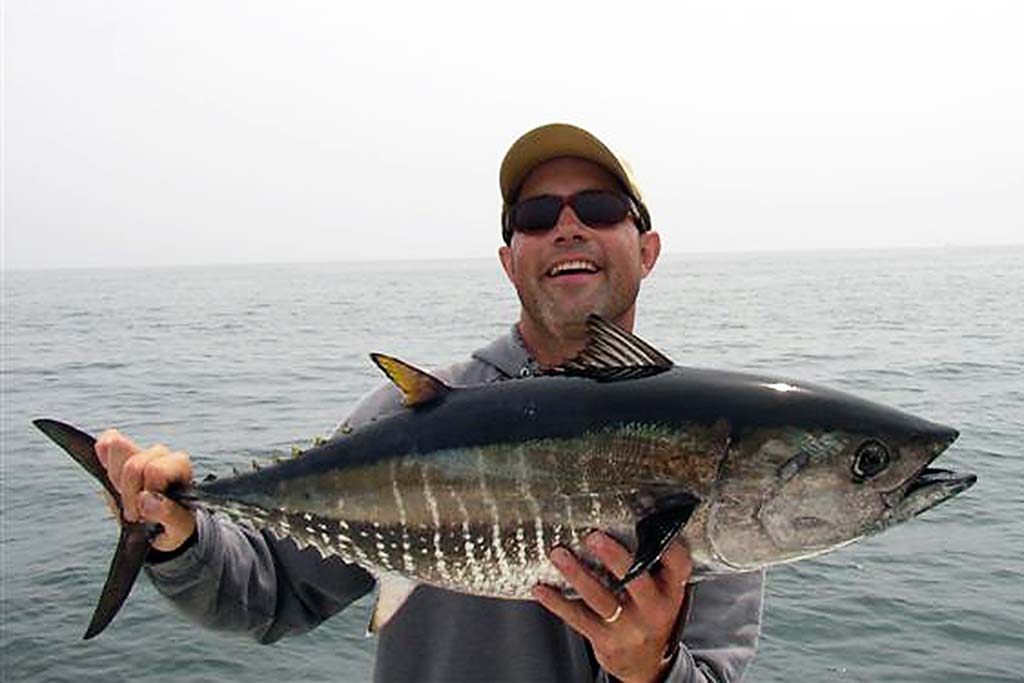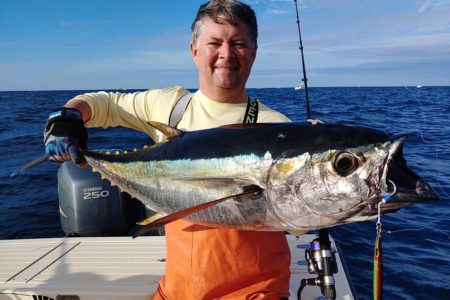A look at one of the most popular and wicked fish in the sea.
Atlantic bluefin tuna, Thunnus thynnus, ranks high enough up on the fishing world calendar that it even has two of its’ own television shows – right up there with the Kardashians! This species is one of the largest pelagic species of finfish found in the northwest Atlantic. Many specimens are caught weighing over 1000 pounds, and measuring eight feet, or more in length.
For this fish, it is mainly left to the hardiest of fishers to pursue bluefin tuna. The expenses alone put it out of reach for the casual weekend fisher. For me, I visit the local supermarket to enjoy their labors from a can.
Bluefin tuna are found in the western Atlantic Ocean from Newfoundland, Canada south to the Gulf of Mexico. This fish has a large, torpedo-shaped body that is pretty much circular in shape around the carcass. Atlantic bluefin tuna is the largest species of tuna on the planet, and can grow up to thirteen feet in length, and weigh up to 2000 pounds.
This species has a dark blue to black coloration on the back and white on the lower sides and tummy. Bluefin tuna have lateral lines that have no color, and rows of colorless spots on their lower sides. The second top or dorsal fin usually has a reddish-brown color, and they have proportionally short pectoral fins. These body features are how you tell the bluefin apart from other members of the tuna genus, Thunnus.
Atlantic bluefin tuna tend to grow at a slower rate than other tuna in the ocean. They live for a long time, of up to 20 years or more and typically do not spawn until they are about 8 years of age. The spawning season runs from mid-April to June, primarily in the Gulf of Mexico. Females can produce up to 10 million eggs a year, depending on the size and age of the fish. The eggs are broadcast and fertilized in the middle of the water column and hatch in about 48 hours, depending upon water temperatures.

Bluefin tuna are top predators – they are the true king of finfish in the sea. Young tuna eat crustaceans, squid, and fish, with adult fish mainly feeding upon baitfish such as herring, bluefish, and mackerel. Sharks, marine mammals including pilot, and killer whales, and other species of large fish will feed on bluefin tuna. Bluefish and seabirds also look at the bluefin as a favorite snack.
This species is managed under the 2006 Consolidated Atlantic Highly Migratory Species Fishery Management Plan along with any amendments. These include commercial and recreational fishermen who are required to have a permit to harvest bluefin tuna. There is also an annual quota and sub-quotas. In addition, there are gear restrictions, time and area closures, and minimum size limits of bluefin tuna.
According to the NOAA Fisheries website, Federal management for Atlantic tunas applies to state waters as well, except in Maine, Connecticut, and Mississippi. NOAA Fisheries periodically reviews these states’ regulations to make sure they’re consistent with federal regulations. These regulations do not allow targeted fishing of bluefin tuna in the Gulf of Mexico, an important spawning area for the species.
NOAA Fisheries published several recent regulations that are expected to reduce and
improve accounting for bluefin tuna dead discards, including gear restricted areas and individual transferable quotas in the pelagic longline fishery, modified quota category allocations, and enhanced monitoring and reporting.
In 2000, the United States established the Dolphin-Safe Tuna Tracking and Verification Program to monitor the domestic production and import of all frozen and processed tuna products nationwide into this country, and to make sure that any fish being caught are done so by using dolphin-safe practices.
For me, the best way to enjoy fishing for the Atlantic bluefin tuna is tuning into my local cable channel and watching it from the comfort and safety of my home – while eating tuna fish sandwiches, or course.



